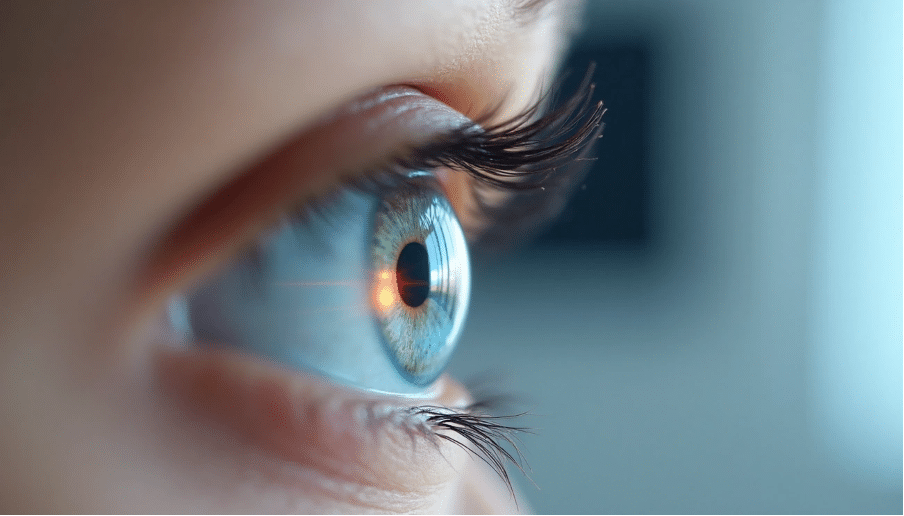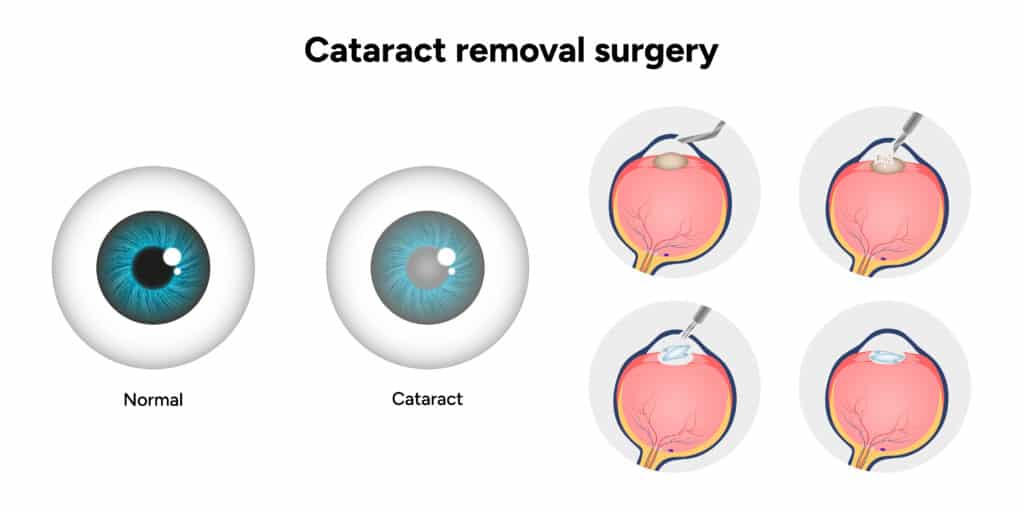Has your vision become cloudy months or years after cataract surgery? YAG laser treatment stands out as the best solution for this common post-surgical condition. Posterior capsular opacification (PCO) causes most cases of blurry vision after cataract surgery. The condition can develop three months after your procedure, though most patients notice it around two years later.
The clouding doesn’t mean your surgery failed – it’s your body’s natural response that affects many patients. YAG laser capsulotomy provides a quick way to treat cloudy vision after cataract surgery. The outpatient procedure takes just 5-10 minutes and improves your vision right away. You can jump back into your daily routine immediately after the treatment!
This piece explains why clouding happens, how YAG laser capsulotomy helps restore clear vision, and what you should expect throughout the process. The information helps you understand your options to maintain the clear vision your original cataract surgery gave you, whether you have symptoms now or want to plan ahead.

Understanding Cloudy Vision After Cataract Surgery
Your vision might become hazy again after a successful cataract surgery. Let’s explore why this happens and when you should see your doctor.
What causes vision to become cloudy again?
Several things can make your vision cloudy after cataract surgery. A bit of blurriness right after surgery is normal because of swelling and inflammation. The cloudiness that shows up months or years later usually points to something else. The main reason for cloudy vision after cataract surgery is posterior capsule opacification (PCO). This feels like your original cataract, but it’s different because your natural lens is already gone. Here are other less common reasons:
- Eye inflammation
- Dry eyes, especially when you have to use antibiotic-steroid eye drops for a long time
- Cystoid macular oedema (retinal swelling)
- Retinal detachment (needs immediate medical attention)
PCO remains the most likely cause when your vision gets worse after surgery that worked well at first.
What is posterior capsule opacification (PCO)?
PCO happens when a thin, cloudy membrane forms on the back part of your lens capsule – the clear “bag” that held your natural lens and now holds your artificial one (IOL). People sometimes call it a “secondary cataract,” but that’s not really accurate. The cloudiness appears because some lens cells left behind after surgery start growing on the posterior capsule. These cells create a hazy layer that blocks light from reaching your retina clearly. So your vision becomes blurry or cloudy, much like it was before your original cataract surgery.
Your risk of getting PCO might be higher if:
- You’re younger, because your cells are more active
- You have conditions like diabetes, glaucoma, high myopia, or inflammatory eye problems
- The type and material of your artificial lens matter too
The signs of PCO include blurry vision, light sensitivity, problems with glare (especially during night driving), and trouble seeing contrast.

How common is PCO in the UK?
PCO stands as the most frequent long-term complication after cataract surgery in the United Kingdom. The Royal College of Ophthalmologists’ National Ophthalmology Database shows about one in five eyes develop PCO after cataract surgery.
The numbers in the UK look like this:
- 4.0% after one year
- 18.0% after three years
- 31.2% after five years
Doctors perform about 472,000 cataract surgeries each year in England and Wales. This means thousands of patients need treatment for PCO annually. The bright side is that doctors can treat PCO easily with a quick, painless procedure called YAG laser capsulotomy. This treatment makes a small opening in the cloudy posterior capsule. Light passes through clearly again, bringing back the better vision you had right after your cataract surgery. These details about PCO help explain the changes in your vision since surgery. Remember, effective treatments exist to bring back the clarity you’re looking for.
What Is YAG Laser Capsulotomy and How It Works
YAG laser capsulotomy works great to restore clear vision when posterior capsule opacification develops. This modern procedure uses special laser technology to quickly fix cloudy vision that can happen after cataract surgery.
How the YAG laser clears the cloudy capsule
The YAG (Yttrium Aluminium Garnet) laser delivers quick bursts of energy to make a small opening in the cloudy posterior capsule behind your intraocular lens implant. Your vision becomes blurry when this cloudy membrane blocks light from reaching your retina’s back. Your ophthalmologist uses the laser to cut a circular section in the affected lens capsule during the procedure. Light passes through clearly once this opening is made. The procedure shows amazing precision—each laser pulse takes just a split second. You’ll hear a clicking sound as the laser creates the opening.
The technical name—Nd:YAG laser capsulotomy—tells us which specific laser is used (neodymium-doped YAG). This laser works at a wavelength of 1064nm, making it perfect for this precise eye procedure. The laser beam stays invisible, but you’ll see a bright focusing light during your treatment.
Why it’s different from cataract surgery
YAG laser capsulotomy is different from your original cataract surgery in several key ways:
- Non-invasive: Your eye needs no cuts, unlike cataract surgery which requires incisions
- Duration: The procedure takes just 5-10 minutes while cataract surgery needs 20-45 minutes
- Recovery: You recover almost right away instead of waiting days or weeks like with cataract surgery
- Anaesthesia: Simple numbing eye drops work well instead of stronger anaesthesia
Cataract surgery removes your eye’s cloudy natural lens and puts in an artificial intraocular lens. YAG laser treatment creates an opening in the cloudy membrane behind that artificial lens without removing anything from your eye.
Is the treatment permanent?
YAG laser capsulotomy gives most patients a permanent fix for posterior capsule opacification. The opening made in the cloudy capsule can’t grow back or close over time. You’ll usually need just one treatment for each eye that needs it. This procedure works really well. Most patients see better right away or within a few days after treatment. Some studies show that in rare cases (approximately 24%), posterior capsular opacity might come back. The good news is that even these rare cases can be fixed with another laser procedure.
Research following patients for five years or more shows that better vision stays clear without serious problems. The technology has helped patients since the 1980s, proving its safety and effectiveness in bringing back clear vision.
What to Expect Before, During and After the Procedure
Learning about what to expect during your YAG laser trip will help you have a smooth experience. Precision Vision London has simplified this process to make your treatment as comfortable as possible.
Preparing for your appointment
YAG laser treatment preparation is straightforward. You can eat and drink normally beforehand and continue taking all regular medications unless advised otherwise. Comfortable, loose-fitting clothes will make your appointment more pleasant. Make sure to arrange transportation home since eye dilation will affect your ability to drive safely. You can resume driving the next day.
Cloudy vision after cataract surgery is common. YAG laser treatment offers a quick, effective solution—and Precision Vision London’s expert team will take great care of you.
What happens during the laser treatment
A nurse will check your vision when you arrive—bring your distance glasses if you use them. Your pupils need dilation with eye drops, which takes about 30 minutes. Your ophthalmologist will then:
- Numb your eye’s surface with anaesthetic drops
- Focus the laser beam using a special contact lens on your eye
- Help you position your chin on the rest and forehead against the bar
- Target the cloudy capsule while you see a bright light
- Make a small opening in the capsule using several quick laser pulses
You’ll hear clicking sounds as the laser fires. Keep your head and eyes still during the procedure. Let your doctor know if you need to move.
How long does the procedure take?
The laser treatment itself takes about 5-10 minutes. Plan to spend approximately two hours at the clinic. This time includes vision testing, pupil dilation, and a brief observation period after the procedure.
Is the treatment painful?
Patients find YAG laser capsulotomy painless. The contact lens used to focus the laser might create gentle pressure, but the laser itself causes no discomfort. Some patients feel a slight “pop” or “shock” in the eye without any pain.
When will vision improve?
Vision improvement happens almost immediately after the procedure. All the same, your vision stays blurry for several hours until the dilating drops wear off. Most patients achieve full vision clarity within 24 hours. Sometimes it takes several days for vision to return completely.
Possible Side Effects and When to Seek Help
YAG laser capsulotomy is a safe and effective procedure. You should know what side effects to expect during your recovery.

Image Source: AARP
Floaters and flashes: what’s normal?
Floaters are very common after YAG laser treatment. You might see harmless clumps of debris from the capsule that look like dots, circles, lines, clouds or cobwebs in your vision. These floaters happen because small pieces of the capsule float in your eye after the laser breaks up the cloudy membrane.
The good news is these floaters usually get better within a few days to weeks. Some patients might notice them longer, but they become less noticeable as your brain adjusts to them. Watch out for any sudden increase in floaters, especially when you see flashing lights too. This could mean something more serious and needs immediate medical attention.
Temporary blurred vision after treatment
Your vision will likely be blurry for several hours after the procedure. The dilating drops used during treatment cause this blurriness and take time to wear off. Make sure you arrange a ride home since you won’t be able to drive right after the procedure. You might feel mild eye irritation along with the blurriness. These effects don’t last long. Most people see their vision improve within 24 hours.
Rare complications to be aware of
These complications don’t happen often, but you should know about them:
- Retinal detachment: This happens in about 1-2% of cases after YAG capsulotomy. You’re more at risk if you’re short-sighted or have had a retinal detachment before.
- Increased eye pressure: Your eye pressure might rise briefly, especially if the procedure needed more laser energy.
- Cystoid macular oedema: This creates fluid-filled sacs on your retina that can affect your vision.
- Inflammation: Some people get inflammation inside their eye, but anti-inflammatory drops usually help.
When to contact your eye specialist
Call your eye specialist right away if you notice:
- Sudden vision loss or your vision gets worse
- A dense cloud or shadow moving in from the edge of your vision
- Several new floaters or a sudden shower of them
- Quick flashes of light, especially with floaters
- Pain that regular painkillers don’t help
- Your eye stays red or gets redder
Here at Precision Vision London, our expert ophthalmologists keep a close eye on patients after YAG laser treatment. We spot and treat any complications quickly.
Why Choose Precision Vision London for YAG Laser Treatment
Choosing the right clinic for your YAG laser capsulotomy will give you the best results and peace of mind. Precision Vision London has emerged as the UK’s leading choice for this vision-restoring procedure.
Our expert surgeons and personalised care
Precision Vision London’s world-renowned surgeons bring unique expertise to your eye care experience. Dr. CT Pillai leads the clinic as Medical Director with distinguished credentials. He is a Fellow of both the Royal College of Ophthalmologists and the Royal College of Surgeons, Edinburgh. Dr. Pillai has spent over 30 years at the vanguard of ophthalmology and has performed more than 50,000 vision correction procedures. Dr. Pillai takes a hands-on approach that sets him apart. He personally oversees all clinical protocols and performs every laser procedure from your original consultation through treatment and aftercare.
Many people experience cloudy vision after cataract surgery. YAG laser treatment offers a quick and effective solution. Precision Vision London’s expert team is ready to help you see clearly again. Book your consultation today. Your care package includes a detailed one-year aftercare programme. You’ll receive ongoing eye care and education specifically tailored to your needs during this time.
Advanced laser technology and safety standards
State-of-the-art technology drives the exceptional results at Precision Vision London. The clinic operates independently with no manufacturer affiliations. This allows the team to choose the best equipment based on performance and patient outcomes. Excellence matters here. The clinic replaces all laser eye surgery equipment every three years. This ensures patients receive treatment with the newest available technology.
Trusted by patients across the UK
The clinic has earned 4.97 out of 5 stars from 166 reviews on Doctify, making it one of London’s most trusted vision correction centres. Patients regularly share stories about their life-changing results. Patient testimonials highlight the exceptional support throughout the process. One patient shared, “I would especially like to thank you for calling up both evenings after surgery to make sure I was both comfortable with what had happened and that I was OK generally”.
“If I had known it was so easy and painless, I’d done it ages ago. This is all down to the excellent care I received from the team”, another patient remarked. These words reflect the trust patients place in Precision Vision London’s expertise.
Conclusion
PCO impacts thousands of UK patients each year. About 20% of people who have cataract surgery develop this condition within three years. Cloudy vision after successful cataract surgery might feel frustrating but has a quick and effective solution. YAG laser capsulotomy remains the gold standard treatment that restores clear vision within 24 hours without pain or invasion.
Dr. CT Pillai’s 30 years of expertise guides patients through their treatment at Precision Vision London. His track record of over 50,000 vision correction procedures gives patients peace of mind during this anxious time. The clinic’s state-of-the-art equipment gets upgraded every three years to give you the best possible treatment. The clinic’s detailed one-year aftercare programme shows their steadfast dedication to your long-term eye health beyond just the procedure. Their patient-first approach has earned a remarkable 4.97/5 rating from 166 UK patients who describe their results as life-changing.
Cloudy vision doesn’t have to stay a constant source of frustration after cataract surgery. The quick YAG laser procedure at Precision Vision London can bring back the clarity you first gained from cataract surgery. Book your consultation today and return to your daily activities with renewed confidence in your vision.
Key Takeaways
If you’re experiencing cloudy vision after cataract surgery, here are the essential insights to help you understand and address this common condition:
- Posterior capsule opacification (PCO) affects 20% of cataract patients within three years, causing cloudy vision similar to original cataracts.
- YAG laser capsulotomy provides a permanent solution in just 5-10 minutes with immediate vision improvement and no recovery downtime.
- The procedure is painless, non-invasive, and requires only numbing drops—completely different from your original cataract surgery.
- Temporary floaters after treatment are normal and harmless, but sudden increases in floaters with flashing lights require immediate medical attention.
- Expert care matters: choose experienced surgeons with advanced technology for optimal results and comprehensive aftercare support.
This quick outpatient procedure can restore the clear vision your cataract surgery initially provided, allowing you to return to daily activities with renewed visual confidence.
FAQs
Q1. How soon after cataract surgery can posterior capsule opacification (PCO) develop? PCO can develop as early as three months after cataract surgery, but it more commonly occurs about two years afterwards. Approximately 20% of patients experience PCO within three years of their cataract procedure.
Q2. Is YAG laser capsulotomy painful? No, YAG laser capsulotomy is generally painless. You might feel gentle pressure from the contact lens used to focus the laser, but there’s no discomfort from the laser itself. Some patients describe feeling a slight ‘pop’ or ‘shock’ in the eye, but confirm it doesn’t hurt.
Q3. How long does it take to see improvement after YAG laser treatment? Most patients notice vision improvement almost immediately after the procedure. However, your vision may remain temporarily blurred for several hours until the dilating drops wear off. Full vision clarity typically develops within 24 hours, though occasionally it may take several days for vision to be fully restored.
Q4. Are there any side effects of YAG laser capsulotomy? The most common side effect is the appearance of floaters, which are usually temporary. Some patients may experience temporary blurred vision or mild eye irritation. Serious complications like retinal detachment are rare, occurring in only about 1-2% of cases.
Q5. How long does the YAG laser treatment take? The actual laser treatment typically lasts only about 5-10 minutes. However, you should plan to be at the clinic for approximately two hours. This additional time allows for vision testing, pupil dilation, and brief post-procedure observation.
Authors & Reviewer
-
 Olivia: Author
Olivia: AuthorHi, I'm Olivia, a passionate writer specialising in eye care, vision health, and the latest advancements in optometry. I strive to craft informative and engaging articles that help readers make informed decisions about their eye health. With a keen eye for detail and a commitment to delivering accurate, research-backed content, I aim to educate and inspire through every piece I write.
-
 Dr. CT Pillai: Reviewer
Dr. CT Pillai: ReviewerDr. CT Pillai is a globally recognised ophthalmologist with over 30 years of experience, specialising in refractive surgery and general ophthalmology. Renowned for performing over 50,000 successful laser procedures.

